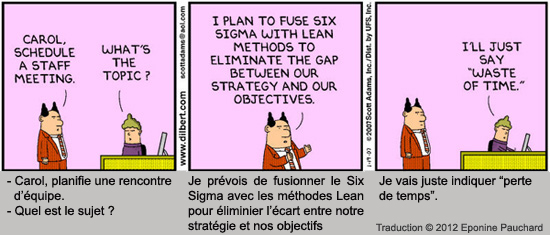“Lean” focuses on reducing waste and making processes more reliable in a context of flows and cycle times. It is applied to processes whose passage time is measured.
“Lean” refers to lean, which is the term its founders chose to describe what they were aiming for. It is an activity that consists of improving productivity. All lean actions will improve productivity, but you can improve profits and your profitability without being lean.

By the way, I could have written almost the same article, replacing “lean” by “agile”. Agile principles also aim to reduce delivery times, with frequent development and short feedback loops.
The principle of flow
We simply observe the process from the moment the customer places an order until we receive payment. We reduce this time by eliminating non-value added.
Taichi Ohno
Any product or service follows a production flow. This is the famous lead time. Not to be confused with takt time or cycle time. Cycle time obviously contributes to delay, but some actions can improve delay without changing cycle time. The pace is, in theory, beyond your control. While you can influence it through advertising or discounts, it is mostly to help you size or level your operations.
Some examples of flows and associated times:
- The customer orders a new car. The factory puts it into production, then delivers it to the customer, who pays on delivery. Delay: 2 to 5 months, cycle time: 5 minutes
- The client calls for an appointment at his hairdresser. A few days later, he shows up, gets a haircut and pays. Delay: 1 week, cycle time: 30 minutes
- The client needs a modification on her website. She contacts her web agency. After a few days, she receives the updates and accepts them. The web agency puts the site into production. The client receives the invoice and pays it. Delay: 5 days, cycle time: 2 days.
- The client needs an audit of his organization. He contacts several consultants. After receiving the proposals, he chooses one. Once the contract is signed, the audit is scheduled a few weeks later. After the audit, the client receives the report and the invoice. He then proceeds with the payment. Delay: 5 months, cycle time: 3 months.
- The client decides to implement an online time management solution. She does her research on the Internet and chooses a solution. Then, she registers on the site, makes the payment and gets access to her solution. Delay: 1 hour, cycle time: a few minutes.
- The customer orders pastries for an event in 1 month. The day before the event, the baker begins the preparation. On the scheduled day, he delivers to his client, who proceeds to pay. Delay: 1 month, cycle time: 6 hours.
Continuous improvement does not always improve the flow
Improving cycle time is the sole objective of lean. As a result, you can continuously improve your operations, reduce production errors, your carbon footprint or your waste volume. You can increase the efficiency of your teams, but if you don’t reduce the cycle time, you are not lean. It’s not a big deal, because you’re improving. But you could have more benefit and more “impact” if you work on cycle time.
If you eliminate non-value added, that’s fine, but there’s nothing new or lean about it. For many years, we have been developing technologies and changing our organization to be more efficient. The plow did not reduce the cycle time, it just reduced the drudgery of a job. It’s continuous improvement, but not lean.
I invite you to continue your continuous improvement projects. Indeed, I firmly believe that we can improve everyone’s working conditions, and that is already a great gain. With this discipline of operational excellence in place, you will be able to get more out of your operations.

Changing the focus of continuous improvement to lean
The next step would be to become lean. To do this, it will be the same tools, but instead of focusing on customer value, you will focus on cycle time. This is one of the values brought to the customer. You don’t just look at the value brought to the customer, you add a context of flow and delay.

So, how lean is your organization? Do inventories turn around faster? Is the time from start to finish of your main process shorter? Do your customers go from contract initiation to contract completion faster? If the answer is no, then you’re not particularly lean, no matter what you’ve done to cut costs, reduce waste or change the culture.
